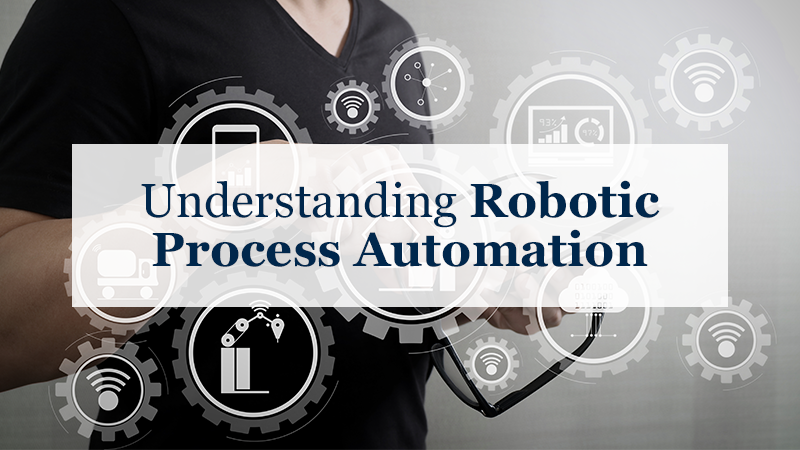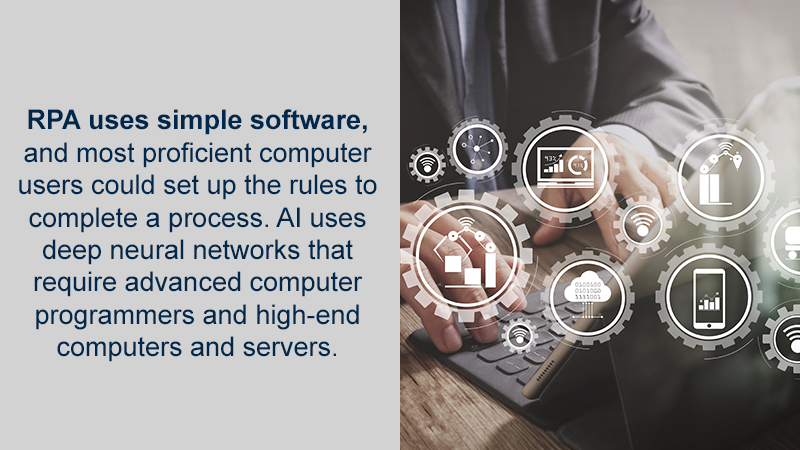Understanding Robotic Process Automation

Two buzzwords of today’s business world – robotic process automation and artificial intelligence – can provide your business with improved customer service, better marketing advice, help you make better financial decisions and assist you in achieving much more. Let’s delve into them to give you a better understanding of how they work and what they can help your business do.
What is Robotic Process Automation?
The term robotic process automation (RPA) can seem confusing to someone new to RPA and artificial intelligence (AI). It involves no physical robot whatsoever. RPA refers to a process and automation software. The software robot, or bot for short, runs on a computer or virtual machine.
The RPA bot lets you write instructions that enable the software to seem human-like in its interactions with a human while managing a multitude of efficient tasks proficiently, productively and efficiently. The RPA bot takes the boring, mundane portions of your staff’s jobs and handles them. Any repetitious computer-based task or process you can automate using a bot.
This may sound dehumanizing, but it is not. The bot simply takes on the task, such as answering emails or responding to customer service questions posed via a chat window. The bot responses are rule-driven, so the bot responds using cues from machine learning plus automation and computer vision.
The best candidates for these RPA bots include business processes requiring humans to complete a repetitive data-driven task at high volume. You can follow four basic criteria to determine if a task could be automated. The task or process needs to:
- Be rule-based,
- Get repeated at pre-set intervals or by a pre-defined trigger,
- Be specific to certain inputs and outputs,
- Have sufficient volume.
These processes can relate to data in any way – receiving, processing, collection, correction, creation, etc. Currently, most RPA gets devoted to customer service, finance and human resources automation. Automating these tasks saves you money, employee hours and can improve morale.
The Difference Between Artificial Intelligence and Robotic Process Automation
While RPA works well with artificial intelligence (AI), the two are not the same thing. RPA does what it is told. AI learns as it goes and hones what it knows. Think of RPA as a worker bee that flies from flower to beehive. Think of AI as the beekeeper who combs out the honey and improves the bees’ setting to help them increase production.
RPA uses simple software, and most proficient computer users could set up the rules to complete a process. AI uses deep neural networks that require advanced computer programmers and high-end computers and servers.

You can use RPA and AI in tandem. The AI learns from customers’ interactions and suggests improved responses to customer questions or requests, while the RPA automates the sending of the response. The RPA functions like an “if/then” statement, while AI hones the response provided in the “then” portion.
AI simulates human intelligence by learning, reasoning and self-correcting. Unlike human thought, though, AI does not make “bad” decisions. It thinks like a logical, rational human who happens to be a genius. It always learns to do better. AI is programmed to want to do better and expand its knowledge, so it integrates what it learns from each customer, client, or contact. AI can re-write responses the RPA bot provides, so the two technologies used together help the business automatically provide better service to its customers. The most common applications of AI include chatbots, image recognition, machine vision, marketing research, natural language generation, speech recognition and sentiment analysis.
Contact Starr & Associates today to learn more about how RPA and AI can help your business move more customers through your sales funnel and increase customer retention. Let us help you get started.